The document discusses lower-level file system algorithms and the concept of inodes, which are critical structures that contain metadata about files and directories, including permissions and data block locations. It explains the differences between disk inodes and in-core inodes, as well as algorithms like iget and iput for managing inodes, along with methods for accessing files and converting file byte offsets into physical disk blocks using the bmap algorithm. Additionally, it highlights the role of directories in the file system structure and the namei algorithm for converting path names to inode numbers.



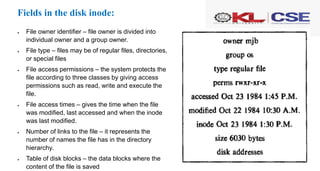


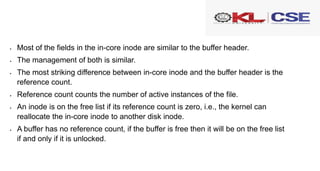

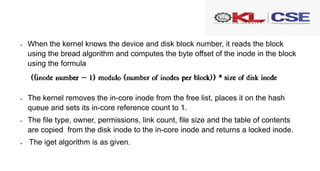




![XV6 Implementation of iget:
5254 iget(uint dev, uint inum)
5255 {
5256 struct inode *ip, *empty;
5257
5258 acquire(&icache.lock);
5259
5260 // Is the inode already cached?
5261 empty = 0;
5262 for(ip = &icache.inode[0]; ip <
&icache.inode[NINODE]; ip++){
5263 if(ip−>ref > 0 && ip−>dev == dev &&
ip−>inum == inum){
5264 ip−>ref++;
5265 release(&icache.lock);
5266 return ip;
5267 }
5268 if(empty == 0 && ip−>ref == 0) //
Remember empty slot.
5269 empty = ip;
5270 }
5271
5272 // Recycle an inode cache entry.
5273 if(empty == 0)
5274 panic("iget: no inodes");
5275
5276 ip = empty;
5277 ip−>dev = dev;
5278 ip−>inum = inum;
5279 ip−>ref = 1;
5280 ip−>valid = 0;
5281 release(&icache.lock);
5282
5283 return ip;
5284 }
5285
5286 // Increment reference count for ip.
5287 // Returns ip to enable ip = idup(ip1)
idiom.
5288 struct inode*
5289 idup(struct inode *ip)
5290 {
5291 acquire(&icache.lock);
5292 ip−>ref++;
5293 release(&icache.lock);
5294 return ip;
5295 }](https://image.slidesharecdn.com/osd-co1session7-240130105325-879408d4/85/osd-co1-session7-pptx-14-320.jpg)
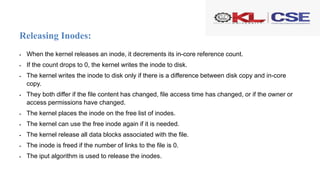







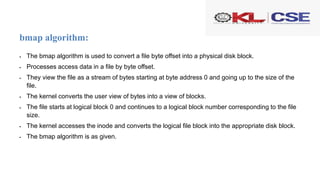
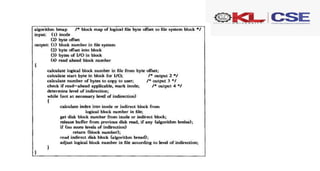

![XV6 Implementation of bmap:
5409 static uint
5410 bmap(struct inode *ip, uint bn)
5411 {
5412 uint addr, *a;
5413 struct buf *bp;
5414
5415 if(bn < NDIRECT){
5416 if((addr = ip−>addrs[bn]) == 0)
5417 ip−>addrs[bn] = addr = balloc(ip−>dev);
5418 return addr;
5419 }
5420 bn −= NDIRECT;
5421
5422 if(bn < NINDIRECT){
5423 // Load indirect block, allocating if necessary.
5424 if((addr = ip−>addrs[NDIRECT]) == 0)
5425 ip−>addrs[NDIRECT] = addr = balloc(ip−>dev);
5426 bp = bread(ip−>dev, addr);
5427 a = (uint*)bp−>data;
5428 if((addr = a[bn]) == 0){
5429 a[bn] = addr = balloc(ip−>dev);
5430 log_write(bp);
5431 }
5432 brelse(bp);
5433 return addr;
5434 }
5435
5436 panic("bmap: out of range");
5437 }](https://image.slidesharecdn.com/osd-co1session7-240130105325-879408d4/85/osd-co1-session7-pptx-26-320.jpg)




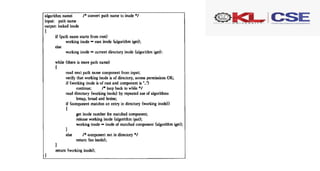
![5754 static struct inode*
5755 namex(char *path, int nameiparent, char *name)
5756 {
5757 struct inode *ip, *next;
5758
5759 if(*path == ’/’)
5760 ip = iget(ROOTDEV, ROOTINO);
5761 else
5762 ip = idup(myproc()−>cwd);
5763
5764 while((path = skipelem(path, name)) != 0){
5765 ilock(ip);
5766 if(ip−>type != T_DIR){
5767 iunlockput(ip);
5768 return 0;
5769 }
5770 if(nameiparent && *path == ’0’){
5771 // Stop one level early.
5772 iunlock(ip);
5773 return ip;
5774 }
5775 if((next = dirlookup(ip, name, 0)) == 0){
5776 iunlockput(ip);
5777 return 0;
5778 }
5779 iunlockput(ip);
5780 ip = next;
5781 }
5782 if(nameiparent){
5783 iput(ip);
5784 return 0;
5785 }
5786 return ip;
5787 }
5788
5789 struct inode*
5790 namei(char *path)
5791 {
5792 char name[DIRSIZ];
5793 return namex(path, 0, name);
5794 }
XV6 Implementation of namei:](https://image.slidesharecdn.com/osd-co1session7-240130105325-879408d4/85/osd-co1-session7-pptx-32-320.jpg)
